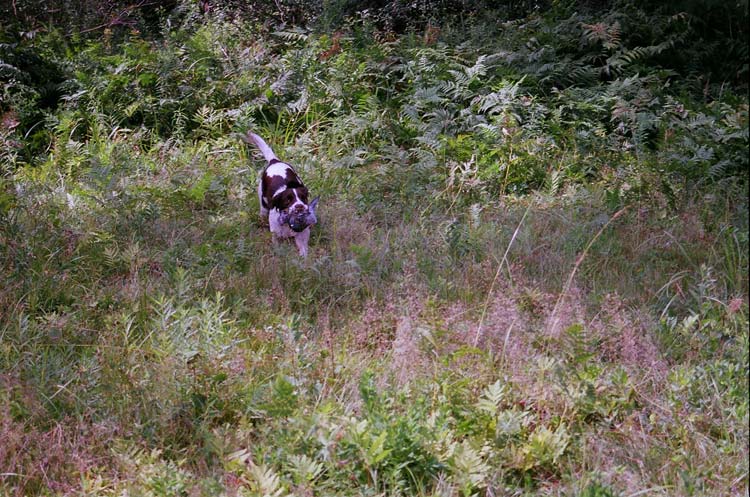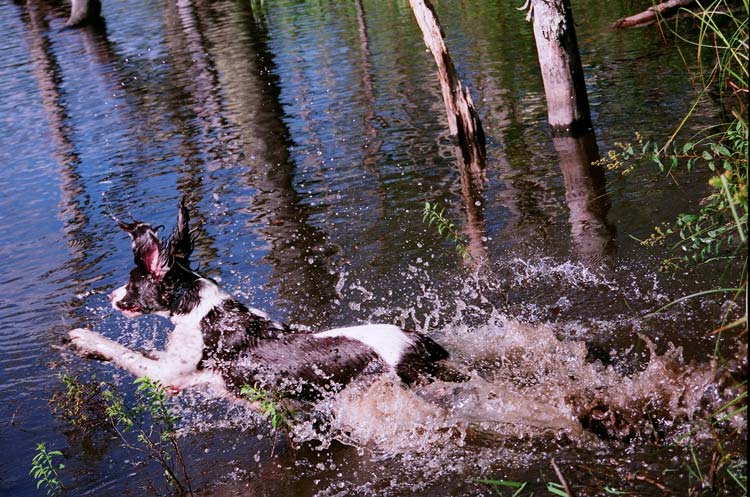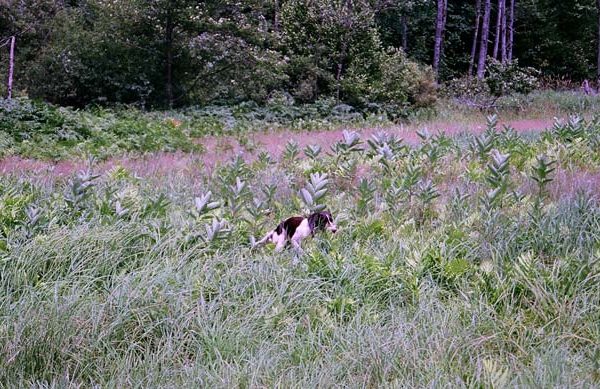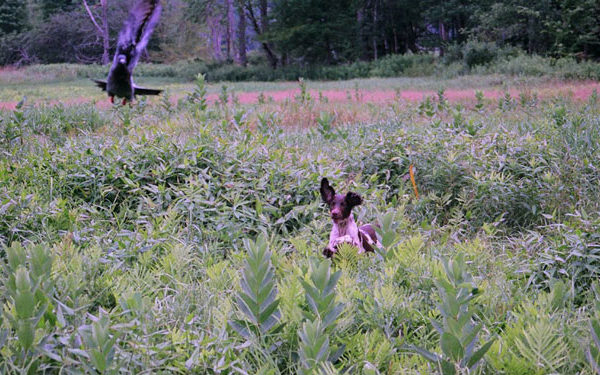
Well folks, you have been at it for some time now and finally your spaniel has started to put together the pieces of the blind retrieve puzzle. The spaniel is now taking a solid initial line, stopping to the whistle, and is executing their casts with enthusiasm. As a result of having taught the 8 legged wagon wheel drill, you should have a fairly good understanding how your spaniel will take a line and cast in different wind directions. Further, your spaniel should be handling all of their casting without any refusals for a minimum of a few week now. Only when this is perfected it is then time to move on to the next stage of training.
We are next going to transition our spaniels to take a line and cast in actual hunting cover. Our training will now address the environmental setting, including natural hazards and different cover changes. The hunting dog will encounter when running a real blind retrieve. You will need to locate an area that will provide many different types of natural cover changes. An area that has a stream bed, some ditches and hedgerows would be ideal for the next step of lining and casting drills. With the use of an area that we have access to we are going to set up as many permanent blind drills that we can to school our spaniel on. Oh what is a permanent blind you ask?
A permanent blind is an established known blind that we will return to, for conditioning our spaniel to maintain good lining and casting in actual hunting cover, terrain and different wind directions. The spaniel will recognize the beginning of the line and the area that they should find birds in. This will build their memory bank of experience on the blind retrieve. Keep in mind that you must study the area closely and really think through where you are going to set up these permanent blinds. Once you establish them you do not want to change the line or find area of that particular blind. Additionally, keep a good distance between one blind verses another. Having the blinds too close to each other can confuse your spaniel on their initial line and the find area. We want to keep it as simple as possible in the early stages of this training drills. When laying out the drills, start simple and short using the wind to your advantage. You can extend their initial line and make it more challenging as they gain confidence when running the blind drills. Try to give the spaniel a diffident environmental hazard to face on every different permanent blind you set up. Making it a lot more challenging to the spaniel. Finally when you do decide on the find area use something in the landscape for the spaniel to lock onto for the running of the initial line. Always attempt to place the bird in line with a large bush or tree. Anything that will stand out in the landscape, giving the spaniel something to lock onto when they are given the “LINE” command.
First, I suggest beginning with a few “hot blinds” drills to facilitate the transition. The “hot blind” is a transition drill that is KNOWN to the spaniel! Thus the spaniel is running the blind “hot”. This is in effect, a conditioning and motivational drill. Once we have conditioned our lining and casting techniques in a natural setting. Then we will begin the actual blind retrieve by the use of a “cold blind” drill.
The most challenging thing that we will be dealing with here is maintaining good attitude and confidence when taking the initial line. It is crucial that your spaniel is successful every time they are sent to find on a blind retrieve. I suggest that you always use fresh dead birds for the spaniel to find during all of the drills that I am going to describe. This will make your spaniel work harder and maintain their good attitude during these permanent blind drills! Start by running some “sight” blinds a minimum of six drills. This will teach your spaniel that they must hold a straight initial line through all diffident types cover and terrain. Naturally we will teach our student one sight blind at a time. Adding an additional blind as they become confident on their blind drills.
So let’s get started on the sight blinds. Mark the beginning and the final destination of the permanent sight blind drills. Place a dead bird at the final destination of the initial line. Retrieve your spaniel and walk them down their initial line to the spot where you have placed the dead bird. Once your spaniel has made visual sight of the dead bird, give them a “dead bird” command. Then turn and walk your spaniel at heel back to the starting point of the blind drill. Turn set you spaniel up wait until they lock onto the landscape item that stands out where the dead bird is. Finally go through your command sequence and send your spaniel for the blind find and retrieve. The spaniel should enthusiastically run a straight line to the find area and make the retrieve easily. However if for some reason they veer off the initial line, give them a NO HERE command. Recalling them back to the beginning. Move them up closer to the find area and resend them. Our goal here is to establish a blind retrieve drill that your spaniel will remember and eventually run without having a visual sight of the dead bird. Later on when you attempt to run this drill COLD. You may wish to shorten up the length of the initial line and extend it only when the dog gains in confidence.
The progression of this drill will eventually show. That your spaniel will have the capability to run several permanent sight blinds in one training session. This specific drill is designed to teach your spaniel to take and maintain an initial line to a specific lock on landmark into the find area. This is a crucial point in blind retrieve training which will assist the spaniel in running for a blind with intent and confidence.
Once this concept has been taught, we will choose some areas to run the “marked Blind” drills for our dogs. Again, mark the beginning and end of your initial line and find area. It will help if you can bring a friend along to assist with this drill. Have your assistant stand out in the find area with dead bird in hand. Get your spaniel and walk to the starting point of your initial line. Have your friend throw a bird up into the air when the spaniel is looking in their direction. As the bird begins to fall from the sky into the cover. Give your spaniel the “dead bird” command. Now remove your spaniel from the area for several minutes to start. Eventually you will build up removing them for a few hours. Return to the starting point of the initial line and send them for the find and retrieve. Should they veer off or need help stop and handle them into the find area. While this is a casting drill, you should try to keep your “OVER” casts as close to a 90 degree angle as possible. Once again we shall build up to doing several of these drills in one training session.
When the spaniel is taking a strong line and is running with solid confidence both pupil and teacher are ready to move onto the next step. Now you are ready to run some “cold blind” drills. I always will run three cold blind drills in one training session, never just one! For the very first few blinds, keep them fairly easy for your spaniel. Make them more difficult as time and experiences are gained. You should be setting things up so that if the proper line is taken they will find the dead bird. Too much handling will cause them to slow down and eventually will lead to “popping”. Popping, or looking to the trainer for reaffirmation, this is a negative learned behavior and is severely punished in many field events.
After you have run your first few cold blinds with your spaniel. You should review what your dog’s weak points that have shown up. Should the issue be handling for example? Then go back to the wagon wheel and permanent marked blind drills to work on handling. I will tend to run 12 permanent blind drills to every 3 cold blinds that we are doing. We are always working on our spaniels weak points while performing that specific series of cold blind. Naturally, the cold blinds will become more complex as we progress. However always remember that each time you send your spaniel on a blind retrieve, he must always be successful and find the blind bird.
With practice, you will be able to run a land blind retrieve whether out in the field while upland bird hunting or at AKC hunting tests. Keep the training going and next month we will use these drills to introduce the water blinds. Water blinds is our final goal, and why we really went through the pains of teaching the handling drills in the first place. See you next month and good training!





